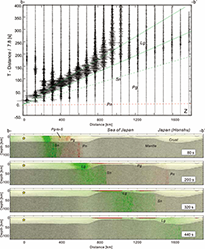** Progress in Earth and Planetary Science is the official journal of the Japan Geoscience Union, published in collaboration with its 51 society members.
** Progress in Earth and Planetary Science is partly financially supported by a Grant-in-Aid for Publication of Scientific Research Results to enhance dissemination of information of scientific research.
Gallery View of PEPS Articles
Research
Solid earth sciences
201405201405
Lg wave propagation in the area around Japan: observations and simulations
Furumura T, Hong T K, Kennett B LN
Computational seismology, Crustal structure, Finite-difference method simulation, Lg wave, Regional wave, Sn wave, Wave propagation
Figure 1 Lg wave propagation map in the area around Japan. Summary map of the variation in the Lg wave propagation in the area around Japan derived from the inversion of the Lg/Sn ratio on the 30,000 ray paths. Green marks efficient Lg propagation, and red marks indicate inefficient Lg propagation. Triangles denote major active volcanoes. Dashed lines denote isodepth contours of the crustal thickness at 5-km intervals, and blue lines correspond to the 1,000-m contour of sea depth. Triangles indicate volcano. Efficient propagation of the Lg wave from Asian Continent to western Japan means that the crustal structure is almost continuous across the Korean Peninsula.
Figure 2 Record section and snapshot derived by 3-D FDM simulation along profile b-b’ in Figure 1. Record section of vertical-component seismogram along profile from the source in China to central Japan across the Sea of Japan and the snapshots of P (red) and S (green) wavefields at 80, 200, 320, and 440 s from earthquake starts. Theoretical travel time curves for the major phases are shown. Star indicates earthquake source. The snapshots demonstrate the propagation of the Pn, Pg,Sn waves and the development of the Lg wave by multiple wide-angle S-wave reflections in the crust. The Lg wave is severely attenuated after propagation of Sea of Japan as the seismic wave penetrate from the crust into the mantle from through thinner oceanic crust, and due to conversion to P wave at the sea bottom. Severely attenuated Lg wave as propagating in the Sea of Japan is also confirmed in the waveform record section at top.
Regional wavefields are strongly influenced by crustal structure heterogeneity variations along their propagation paths. Observations of such effects between the Asian continent and the Japanese subduction zone across the Sea of Japan (East Sea) have been strongly assisted recently by the development of high-density seismic networks in Japan and Korea, as well as the supercomputer-based three-dimensional finite difference method seismic wave propagation simulations using detailed heterogeneous crustal models. In this study, an Lg propagation map derived from 289,000 ray paths connecting sources to observation stations reveals efficient Lg wave propagation from continental Asia to Kyushu through the Korean Peninsula, and to Hokkaido, thus indicating a laterally consistent crustal structure extending from continental Asia to Japan. However, the Lg wave propagation to the Japanese main island of Honshu is totally blocked as it crosses the continental-oceanic boundary surrounding the Sea of Japan. Three-dimensional (3-D) finite-difference method seismic wave propagation simulations performed using a detailed crustal structural model allow us to clearly visualize the way in which an Lg wave develops from a shallow source in the crust and its propagation in the crustal waveguide by means of multiple post-critical S wave reflections in the continental structure. The sudden thinning of the continental crust at the edge of the Asian continent adjacent to the oceanic crust in the Sea of Japan, which involves a thickness change from 30 to 10 km within a 100-km distance (with the thinner crust extending over 600 km), decreases the Lg wave energy by 10%. It has been confirmed that 50% of this Lg wave energy loss occurs during wave passage along the thinner crust and that the other 50% results from conversion into P energy in the overlying seawater.







